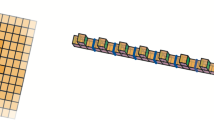Abstract
A compartmentalized surface model of Nambu and Goto is studied on triangulated spherical surfaces by using the canonical Monte Carlo simulation technique. One-dimensional bending energy is defined on the skeletons and at the junctions, and the mechanical strength of the surface is supplied by the one-dimensional bending energy defined on the skeletons and junctions. The compartment size is characterized by the total number L′ of bonds between the two-neighboring junctions and is assumed to have values in the range from L′ = 2 to L′ = 8 in the simulations, while that of the previously reported model is characterized by L′ = 1, where all vertices of the triangulated surface are the junctions. Therefore, the model in this paper is considered to be an extension of the previous model in the sense that the previous model is obtained from the model in this paper in the limit of L′↦1. The model in this paper is identical to the Nambu-Goto surface model without curvature energies in the limit of L′↦∞ and hence is expected to be ill-defined at sufficiently large L′. One remarkable result obtained in this paper is that the model has a well-defined smooth phase even at relatively large L′ just as the previous model of L′↦ 1. It is also remarkable that the fluctuations of surface in the smooth phase are crucially dependent on L′; we can see no surface fluctuation when L′≤ 2, while relatively large fluctuations are seen when L′≥ 3.
Similar content being viewed by others
References
H. Hotani, J. Mol. Biol. 178, 113 (1984)
K. Akiyoshi, A. Itaya, S.M. Nomura, N. Ono, K. Yoshikawa, FEBS Lett. 534, 33 (2003)
U. Seifert, Fluid Vesicles, in Lecture Notes: Physics Meets Biology. From Soft Matter to Cell Biology (35th Spring Scool, Institute of Solid State Research, Forschungszentrum Jülich, 2004)
H.-G. Dobereiner, U. Seifert, Eurpphys. Lett. 36, 325 (1996)
D. Nelson, The Statistical Mechanics of Membranes and Interfaces, Statistical Mechanics of Membranes and Surfaces, edited by D. Nelson, T. Piran, S. Weinberg, 2nd edn (World Scientific, 2004), pp. 1–16
G. Gompper, M. Schick, Self-assembling Amphiphilic Systems: Phase Transitions and Critical Phenomena 16, edited by C. Domb, J.L. Lebowitz (Academic Press, 1994), pp. 1 - 176
M. Bowick, A. Travesset, The Statistical Mechanics of Membrane, Phys. Rep. 344, 255 (2001)
L. Peliti, S. Leibler, Phys. Rev. Lett. 54, 1690 (1985)
F. David, E. Guitter, Europhys. Lett, 5, 709 (1988)
M. Paczuski, M. Kardar, D.R. Nelson, Phys. Rev. Lett. 60, 2638 (1988)
U. Seifert, K. Berndl, R. Lipowsky, Phys. Rev. A 44, 1182 (1991)
E. Evans, Biophys. J. 14, 923 (1974)
M. Jaric, U. Seifert, W. Wintz, M. Wortis, Phys. Rev. E 52, 6623 (1995)
G. Gompper, D.M. Kroll, in Statistical Mechanics of Membranes and Surfaces, edited by D. Nelson, T. Piran, S. Weinberg 2nd edn. (World Scientific, 2004), p. 359
W. Helfrich, Z. Naturforsch, 28c, 693 (1973)
A.M. Polyakov, Nucl. Phys. B 268, 406 (1986)
H. Kleinert, Phys. Lett. B 174, 335 (1986)
Y. Kantor, D.R. Nelson, Phys. Rev. A 36, 4020 (1987)
J. Ambjorn, A. Irback, J. Jurkiewicz, B. Petersson, Nucl. Phys. B 393, 571 (1993)
H. Koibuchi, Eur. Phys. J. B 45, 377 (2005)
J-P. Kownacki, H.T. Diep, Phys. Rev. E 66, 066105 (2002)
H. Koibuchi, T. Kuwahata, Phys. Rev. E 72, 026124 (2005)
I. Endo, H. Koibuchi, Nucl. Phys. B 732, 426 (2006)
H. Koibuchi, Z. Sasaki, K. Shinohara, Phys. Rev. E 70, 066144 (2004)
H. Koibuchi, N. Kusano, A. Nidaira, Z. Sasaki, K. Suzuki, Eur. Phys. J. B 42, 561 (2004)
H. Koibuchi, J. Stat. Phys. 127, 457 (2007)
H. Koibuchi, Eur. Phys. J. B 57, 321 (2007)
H. Koibuchi, Eur. Phys. J. B 59, 55 (2007)
H. Koibuchi, Eur. Phys. J. B 59, 405 (2007)
H. Koibuchi, Phys. Rev. E 75, 051115 (2007)
H. Koibuchi, Eur. Phys. J. B 52, 265 (2006)
J. Ambjorn, B. Durhuus, J. Frohlich, Nucl. Phys. B 257, 433 (1985)
Author information
Authors and Affiliations
Corresponding author
Rights and permissions
About this article
Cite this article
Koibuchi, H. Shape transformation transitions in a model of fixed-connectivity surfaces supported by skeletons. Eur. Phys. J. B 66, 85–90 (2008). https://doi.org/10.1140/epjb/e2008-00384-5
Received:
Revised:
Published:
Issue Date:
DOI: https://doi.org/10.1140/epjb/e2008-00384-5



